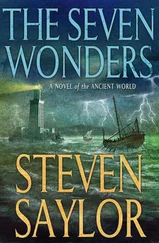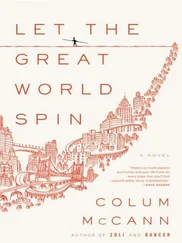Late in the evening on 17 August 1807, the Smeaton finally set sail. Ships in the harbour were flying their colours and friends and family had gathered on the quay to see the men leave. As the ship moved slowly out of the harbour towards the darkening sky, the sound of cheers rang out across the water and echoed around the town and then was lost to the sound of the waves.
They reached the rock, hissing and frothy with surf, at dawn the next morning. There was an air of excitement at being in such a strange place. It was too early to start work with the tide still pushing water over their feet, so Stevenson raised three cheers and poured a ration of rum to the men. By 6 a.m., the water had retreated and some of the workmen began drilling holes for the beams that would support the beacon. The smith, James Dove, who would soon be busy sharpening tools, found a sheltered corner near a rock pool while other men cleared seaweed away from the pitted and uneven surface of the slippery rock. A seaweed called dulse was collected with enthusiasm; many of the men were suffering from seasickness and this was thought to be an antidote. When the tide returned, the men were thankful to row back to the relative security of their temporary accommodation on the Smeaton. As they pulled away, the rock that only minutes before had been a firm foothold was swallowed up before their eyes, with not even a ripple to mark its position.
Calm weather with whispering seas and wide, pearly-gold skies of late summer surrounded the enterprise in the first few weeks. Stevenson’s first task was to set up the forge. Everybody helped James Dove erect the iron framework which would form the hearth. This was supported by four legs set up to twelve inches into the rock and secured with iron wedges. A huge block of timber which would carry the anvil was treated in the same way and water was fast encroaching again as the weighty anvil was placed. James Dove was invariably up to his knees in water and sometimes up to his waist but this was considered a minor problem compared to keeping the forge fire from the ever-playful waves.
The next task was to start work on the temporary hut or beacon. This was uppermost in everyone’s minds since if there were an accident to the rowing boats when attempting to land, then this beacon on the Bell Rock would at least provide something to cling to until rescue arrived. Willing hands took on the difficult task of gouging out the hard sandstone that would take the stanchions supporting the uprights. Fifty-four holes in all, each two inches in diameter and eighteen inches deep, were needed to hold the iron stanchions. The upper part of the stanchions above ground would be riveted into the six massive 50-foot upright beams that formed the core framework of the beacon and other supporting beams.
One morning as the men rowed towards the rock, Stevenson was astonished to see what looked like a human figure lying on a ledge of rock. His mind was in turmoil, assuming that there must have been a shipwreck in the night and the place would be littered with dead bodies. He was afraid his men would want to leave. They would see the Bell Rock living up to its reputation as a place of dread. As soon as he landed, and without a word, he made his way quickly to where the ‘body’ lay, only to discover, with immense relief, that it was, in fact, the smith’s anvil and block.
Six days after leaving Arbroath, the men, who had been very cramped on the Smeaton, were transferred to the lightship Pharos , now anchored a mile away. Everyone was pleased to be going to the larger ship, which had a well-equipped galley and bunks for the men. Her only drawback was that she did roll rather badly even in light winds. This made it extremely difficult for the men even to get into the rowing boats for the mile-long row to the rock. Indeed, her rolling was so great ‘that the gunwale, though about five feet above the surface of the water, dipped nearly into it upon one side,’ recorded Stevenson, ‘while her keel could not be far from the surface on the other’. Everyone hoped the good weather would continue, not daring to imagine what she would be like if the weather turned. Seasickness, which had largely been conquered, now became a very big problem. Even Stevenson was affected.
On Saturday night, all hands were given a glass of rum and water and every man made a contribution to the occasion, singing, playing a tune or telling a story, so that the evening passed pleasurably, ending with the favourite toast of ‘wives and sweethearts’. By Sunday morning, however, the atmosphere was much changed. There was the seriousness of breaking the Commandments to be considered. Several were opposed to working on the Sabbath, but Stevenson pointed out that their labour was an act of mercy and must continue without fail, although he emphasised no one would be penalised for following his conscience. Prayers were said, and then Stevenson, without looking back, stepped into the boat. To his relief, he was followed by all but four of the masons.
Several days passed with work progressing well. The site for the lighthouse was marked out, a huge circle 42 feet in diameter in the middle of the reef, and the foundation holes for the beacon house were underway. On 2 September, however, their luck changed. A strong wind blew up and a crew from the Smeaton, who had rowed to the rock that morning, bringing eight workmen, was concerned that the Smeaton might break loose from her riding ropes and took its rowing boat back to check. No sooner had it reached the Smeaton than she broke from her moorings and began drifting at speed. The men who had remained on the rock were so intent on their work that they did not notice the rowing boat leave, or see that the Smeaton herself was floating quickly away.
Stevenson, alone, realised their terrible dilemma. He could see that with the wind and tide against her, the Smeaton could never get back to the Bell Rock before the tide overflowed it. There were 32 men working on the rock and only two boats, which in good weather might hold twelve men each. But now the wind was blowing in heavy seas. In such conditions, it would be fatal to put more than eight men in each boat to row the mile back to the floating light. It meant that there was transport for only half the men.
He watched the ship too far away to help and the men still involved in their work. As he stood there, trying to make sense of this insoluble problem, the waves came in with a sudden fury, overwhelming the smith’s fire, which was suddenly put out with a protesting sizzle and hiss. Stevenson himself was now ‘in a state of suspense, with almost certain destruction at hand’.
With the obscuring smoke gone and the sea rolling quickly over the rock, the workmen gathered their tools and moved to their respective boats to find, not the expected three boats, but only two. Stevenson watched helplessly as the men silently summed up the situation, only too aware of the rock fast disappearing under the sea. They waited. ‘Not a word was uttered by anyone. All appeared to be silently calculating their numbers, and looking to each other with evident marks of perplexity.’
A decision had to be made. Soon the rock would be under more than twelve feet of water; they would have to take their chances. Sixteen men could go in the boats and the rest would have to hang on somehow to the gunwales while they were rowed carefully back through the boisterous seas to the Smeaton, now three miles away. There was no point trying to row to the Pharos, although it was nearer, as she lay to windward. Those clinging on to the rowing boats would stand little chance. So which men could have a place in the boats?
Stevenson was about to issue orders, but found his mouth was so dry he could not speak. He bent to a rock pool to moisten his lips with the salty water and, as he did, heard someone shout, ‘A boat! A boat!’
Читать дальше












